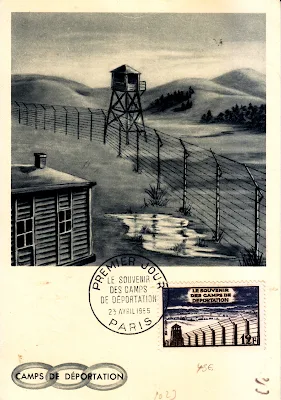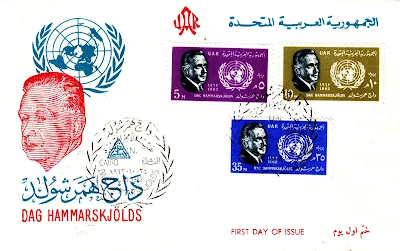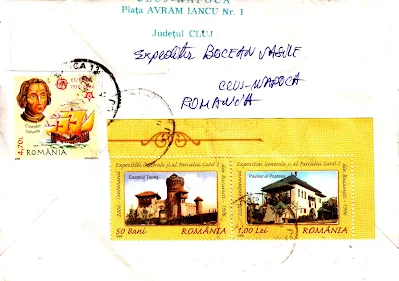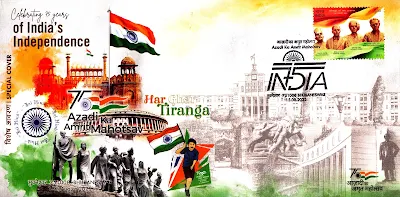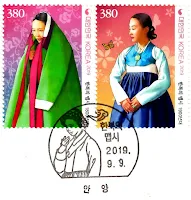Ernst Ingmar Bergman (1918 – 2007) was a Swedish film and theatre director and screenwriter. Widely considered one of the greatest and most influential film directors of the 20th century, his films have been described as "profoundly personal meditations into the myriad struggles facing the psyche and the soul". Some of his most acclaimed works include "The Seventh Seal" (1957), "Wild Strawberries" (1957), "Persona" (1966) and "Fanny and Alexander" (1982).
Myriad philatelic content from around the world, such as first day covers, block stamp sets, maxicards, may be found at this website.
Monday, April 29, 2024
PostNord Centenary Birth Anniversary of Ingmar Bergman
Ernst Ingmar Bergman (1918 – 2007) was a Swedish film and theatre director and screenwriter. Widely considered one of the greatest and most influential film directors of the 20th century, his films have been described as "profoundly personal meditations into the myriad struggles facing the psyche and the soul". Some of his most acclaimed works include "The Seventh Seal" (1957), "Wild Strawberries" (1957), "Persona" (1966) and "Fanny and Alexander" (1982).
Saturday, April 27, 2024
PostNord 50th Anniversary of ABBA Winning Eurovision
That was on 6 April 1974 when Agnetha Fältskog, Björn Ulvaeus, Benny Andersson and Anni-Frid “Frida” Lyngstad -- ABBA, for short -- entered the already colourful stage at The Dome in Brighton dressed in shiny glam-rock costumes typical of the era.
To celebrate half a century of iconic pop music loved by listeners the world over, NordPost released an exclusive series of three stamps, sheetlets and maxi card, all postmarked from Stockholm, Sweden.
Source: PostNord
Thursday, April 25, 2024
Oesterreich Post 150th Birth Anniversary of Alfons Mucha and "The Zodiac Signs"
La Poste France 1oth Anniversary of the Liberation of Deportation Camps
Dag Hammarskjold First Day Cover Issues from Various Countries
Dag Hammarskjold's his father, Hjalmar Hammarskjold, was prime minister of Sweden from 1914 to 1917. Dag Hammarskjold attended Uppsala University where he obtained degrees in economics and law, and began working for Sweden in governmental positions related to finance and foreign affairs.
 He joined the Swedish delegation to the United Nations in 1949 and was named acting chairman of the delegation in 1952. Following the 1953 resignation of UN Secretary-General Trygve Lie, Hammarskjold was elected to fill the position, and was elected for a second term in 1957.
He joined the Swedish delegation to the United Nations in 1949 and was named acting chairman of the delegation in 1952. Following the 1953 resignation of UN Secretary-General Trygve Lie, Hammarskjold was elected to fill the position, and was elected for a second term in 1957.
The United Nations biography of Hammarskjold states that "During his terms as Secretary-General, Mr. Hammarsjkold carried out many responsibilities for the United Nations in the course of its efforts to prevent war and serve the other aims of the Charter." These include diplomatic activity in the Middle East, and negotiations with China for the release of detained American military pilots.
Wednesday, April 24, 2024
PostNords "The Service of Humanity"
Source: Wikipedia
Nepal Post Nepalese Influential Personalities - 1969
50 Paisa - Bhimsen Thapa (1775 –1839 CE) was a Nepalese statesman who served as the Mukhtiyar (equivalent to prime minister) from 1806 to 1837 CE. He is widely known as the longest-serving prime minister of Nepal. Born into an ordinary military family in the Gorkha Kingdom, Bhimsen first came close to the Crown Prince Rana Bahadur Shah at an early age in 1785 CE. In 1798, he was recruited as a bodyguard for the King by his father. Thereafter, he rose to influence after helping the exiled ex-King Rana Bahadur Shah engineer his return to power in 1804 CE. In gratitude, Rana Bahadur made Bhimsen a Kaji (equivalent to a minister) of the newly formed government. Widely considered one of the 19th century's most significant figures in Nepalese history, Bhimsen is seen as a patriotic, clever, and diplomatic statesman who played an important role in defending his country against then-widespread British colonial imperialism in South Asia.
Monday, April 22, 2024
Sunday, April 21, 2024
Wednesday, April 17, 2024
India Post 75th Anniversary of Indian Independence & The Four Great Martyrs of Solapur
Monday, April 15, 2024
Kuwait Post 1st Anniversary of the Iraqi Invasion
Stamps issued:
- 50 Fils - Human Terrorism
- 100 Fils - Invasion of Kuwait
- 150 Fils - Environmental Terrorism
- 250 Fils - Desert Storm imperforated minisheet
The Persian Gulf War occurred after Iraq invaded Kuwait on 2 August 1990. The war was fought between Iraq and a coalition of 39 countries, organised mainly by the United States and the United Nations. The war took place in Iraq and the tiny, oil-rich nation of Kuwait.
Western governments believed Iraq was prepared to invade Saudi Arabia next, and that the world’s supply of petroleum was in jeopardy. The coalition placed embargoes on Iraq, but its military forces refused to retreat. On 17 January 1991, the bombing of Iraqi military and industrial targets began. A massive ground attack was launched in February, and the Iraqis were quickly defeated and driven out of Kuwait.Immense human suffering in the Middle East occurred as a result of the war. Environmental damage occurred when the Iraqis set hundreds of Kuwaiti oil wells on fire and dumped huge amounts of oil into the Persian Gulf.
Saturday, April 13, 2024
La Poste France Discovery of HIV
Friday, April 12, 2024
La Poste France Albert Camus
Wednesday, April 10, 2024
Korea Post Hanbok Fashion
KOREA POST on 9 September 2019 issued a set of four First Day Cover stamps on traditional Korean clothing or Hanbok fashion from 1500s till 1900s. Shin Jaeyong designed the stamps, whereas Southern Colour Print for POSA printed 672,000 stamps, using an Offset 4 Colour printing method. Each stamp carried a face value of 380 Korean Won.
380 Korean Won - The 1800s Hanbok
380 Korean Won - The 1900s Hanbok
The Style of Hanbok
Concorde SST Jetliner Air France Postcard and Royal Mail Stamp
Royal Mail January 2007 issued a set of ten stamps celebrating 20th-century British design classics, among these being the Anglo-French Concorde super sonic airliner.
Korea Post Modern Korean Artists - 2018
Korea Post Cover Letter with Random Stamps
Nippon Post Kenrokuen Four Seasons in Ishikawa Prefecture
Designs:
- Kaisekitou Pagoda in Spring
- Fountain in Summer
- Kinjou-reitaku spring in Autumn
- Kotoji stone lantern and yukitsuri in Winter







